The Meewasin Trail may be known for providing opportunities to connect with nature, snap photos of bridges, and learn Saskatoon history, but there are also many artistic and culturally-rich experiences to have while visiting the Meewasin Valley!
Even when a world-wide pandemic has halted many of the street fairs, festivals, and you know, regular summer and fall activities – there is still so much to see in Saskatoon!
Activity, 45 – 120 minutes
Ranked as one of the sunniest cities in Canada that also surrounds a beautiful river valley, Saskatoon is fortunate to boast over 90 kilometers of trail to explore the nature stewarded by Meewasin. The Meewasin Valley offers seemingly endless opportunities to witness stunning views on a lovely day in Saskatoon.
If you’re looking for an all-season, physically-distanced-safe, picturesque activity that combines both nature and culture in Saskatoon, then you’re reading the right blog! In addition to viewing some of the hundreds of fascinating species that call the Meewasin Valley home, you can find a lot of interesting (often) locally crafted public art along the Meewasin Trail!
To simplify your planning, we are going to share the details on a focused, logically organized outdoor experience that with a little movement, will help discovery many neat gems that offer amazing visual stories that turn into Instagramable #MeewasinMoment-s!
Welcome to what we call the Meewasin Southwest Outdoor Public Art Tour!
The Coming Spring
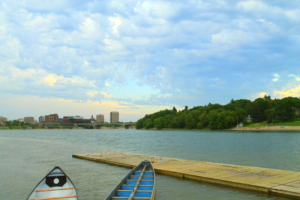
We recommend beginning your tour at the Victoria Park Boathouse where you can start by taking in the views of the wide open river from the end of the dock. Making sure to be courteous to any paddlers, start walking East on the Meewasin Trail heading downtown. before long, you’ll notice (either by sight or by sound) the large, 27-foot tall wind arch featuring a wind chime with two spires made entirely of stainless steel, named The Coming Spring. The Coming Spring, by Canadian artist, Gordon Reeve, was commissioned by the Saskatoon Tribal Council and the City of Saskatoon, with funding from the Government of Canada. The concept was selected and developed with extensive input from the community and guidance from Elders and Indian  residential school survivors.
residential school survivors.
Its creation is in response to the Truth and Reconciliation Commission of Canada’s Calls to Action, No. 79: Participate in a strategy to commemorate the contributions and history of Aboriginal peoples to Canada. The longer, 47-foot spire, pointing north, symbolically represents the First Nations’ long history. The 39-foot spire, pointing south, symbolically represents the history of the Métis Nation. Suspended high on each spire are moving chimes. The rustling and bell-like sounds the chimes make suggest the voices of children heard at a distance, representing the children taken by the residential system from all of the communities in Treaty Six Territory.
The Zhongshan Ting
Next, just East of The Coming Spring, another large installation in Victoria Park sits facing the South  Saskatchewan River. This multi-patterned pagoda (as it’s known in English) is a commemoration to the first Chinese immigrants and their contributions to the early Saskatoon. It is officially called The Zhongshan Ting, which in the Chinese culture, a zhongshan ting is a communal place of worship and fellowship. The Zhongshan Ting is a perfect place to find some shelter or rest from the sun or rain while retaining a great view of the river.
Saskatchewan River. This multi-patterned pagoda (as it’s known in English) is a commemoration to the first Chinese immigrants and their contributions to the early Saskatoon. It is officially called The Zhongshan Ting, which in the Chinese culture, a zhongshan ting is a communal place of worship and fellowship. The Zhongshan Ting is a perfect place to find some shelter or rest from the sun or rain while retaining a great view of the river.
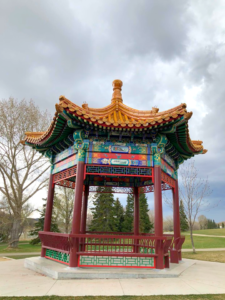
This piece was graciously donated to the City of Saskatoon by the Zhongshan Ting Society. They hope the pillared structure will be a place to learn about Chinese architecture and culture. The committee also wants to see it used for weddings, school field trips, and Tai Chi classes while offering beautiful views near the riverbank.
Continue walking towards downtown, passing by the outdoor gym and under the Senator Sid Buckwold Bridge, to find yourself transitioning into Riverlanding, which features colourful flags, coverings and features. As you walk East, you’ll notice the striking Pavilion Building that houses year-round washrooms and Riverlanding Snacks, then you’ll see the River Landing Spray Park, which is a display that educates about the Saskatchewan River Basin with a model showing geography and hydrology of the basin.
Launch Time
After passing by on the amphitheater, there is a winding trail that can lead you to the upper trail into downtown and towards the Meewasin Office building. Before climbing the winding trail, you’ll notice on the grass, a lineup of stones in the ground, which is a inquisitive display called Launch Time! Created by Prairie Design Group, a collective of four Saskatchewan artists (Mel Bolen, Charley Farrero, Michael Hosaluk, Sean Whalley). Launch Time is designed to engage the community, spark imagination, and encourage conversation on the role 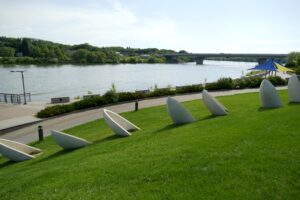 and purpose of public art.
and purpose of public art.
The Design Group noted that “the work is evocative and playful, so that perceptions change and curiosity builds as the viewers move around the piece. Launch Time complements other aspects of the River Landing development, helping to make it a unique community space for all to enjoy.” Launch Time was commissioned by the Saskatchewan Arts Board as a Cultural Capital of Canada project celebrating the City of Saskatoon’s Centennial, and is also a blast to play peek-a-boo or have a fun photo shoot in with friends!
Prairie Wind
Once you’ve had a chance to let your imagination run wild and take a rest inside one of the Launch Time piece (or canoes?), wander up the rest of the winding trail up to the upper sidewalk, known as the Joni Mitchell Promenade – which pays tribute to the Saskatoon-native songstress. Head west towards the Remai Modern Art Museum, and prepare to be stunned by the art installment named 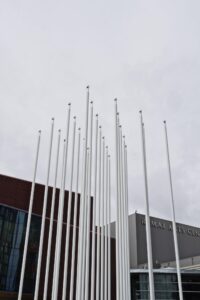 Prairie Wind, which features 25 towering poles that are 15 metres tall and made of steel. The piece also features 16 state-of-the art LED floodlights at the base of the landmark which are controlled by a computerized system that allows the colours to change during different seasons and for special events. The base of the poles incorporate rubber bearing pads that allow the poles to move in the wind.
Prairie Wind, which features 25 towering poles that are 15 metres tall and made of steel. The piece also features 16 state-of-the art LED floodlights at the base of the landmark which are controlled by a computerized system that allows the colours to change during different seasons and for special events. The base of the poles incorporate rubber bearing pads that allow the poles to move in the wind.
Prairie Wind was chosen out of 26 submissions for the design, fabrication and installation of a landmark in River Landing. The public, along with a community selection jury and City Council all provided input for the final decision. In the end, City Council chose “Prairie Wind” submitted by a team consisting of Lee-Koopman Projects from London, England, and Friggstad Downing Henry Architects of Saskatoon.
Tying back to the natural landscape adjacent to it, the plaza is made of a combination of poured concrete with stamped grass and river rock, connecting the urban environment with the prairie and the river. Prairie Wind draws its inspiration from the wind and the grasses that grow in abundance throughout the prairies and parkland surrounding the city. The experience of watching a field of tall grass swaying in the wind is one that is shared by all Saskatchewan people. As noted by the selection jury, “Prairie Wind serves as a visual link between the urban and the rural, the old and the new, the high- tech and the organic.”
Cut-out of Time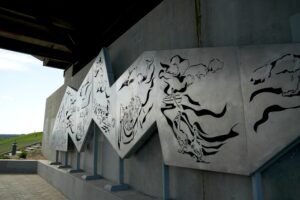
Lastly, meander towards the underside of the new Traffic Bridge off of Victoria Street. Turn your view away from the magnificent arches for a moment and notice the glimmer of the silver from the art piece named Cut-out of Time. This beautiful, carved display physically reflects the river, and symbolically reflects the significance of the river to Saskatoon’s development sits on the inner, north side of the bridge.
In December 2006, calls for submissions were distributed to invite “Expressions of Interest” to design, fabricate, and install an artistic interpretive element that reflects the significance of the river to Saskatoon’s development. On March 26, 2007, City Council approved the purchase of the “Cut-out of Time” interpretative element by Elizabeth Yonza for tentative placement on the north side of the Riverfront path beneath the Traffic Bridge.
Now Go Explore!
There is a ton of cool displays to see in the city, including the University of Saskatchewan’s Sculpture Garden which is adjacent to the Meewasin Trail behind the Diefenbaker Centre, or the City of Saskatoon’s Public Art Collection but we’re happy you stuck around to learn about one of our favourite areas!
There are so many picture worthy spots to 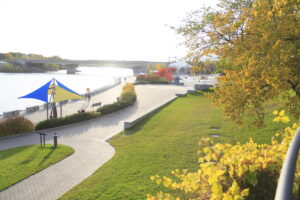 explore in the Meewasin Valley and the eight bridges are only the beginning! We hope you enjoyed our ‘tour’ and discover these new areas for yourself, or if you’re already familiar with the spots, that you learned a bit about some of the culturally-rich art installments in the Southwest area of Saskatoon! Now go explore and tag us on social media for a chance to get featured!
explore in the Meewasin Valley and the eight bridges are only the beginning! We hope you enjoyed our ‘tour’ and discover these new areas for yourself, or if you’re already familiar with the spots, that you learned a bit about some of the culturally-rich art installments in the Southwest area of Saskatoon! Now go explore and tag us on social media for a chance to get featured!
References
https://globalnews.ca/news/2398743/new-chinese-ting-artwork-unveiled-in-saskatoon/
http://www.riverlanding.ca/project_update/phase1/prairie_wind/official_unveiling_programme.pdf
http://www.riverlanding.ca/project_update/phase1/riverfront_path_art/index.html




